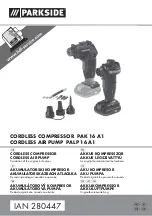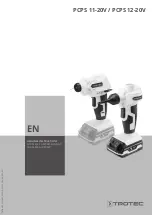
RWF ROTARY SCREW COMPRESSOR UNITS
MAINTENANCE
S70-600 IOM
Page 35
JORDAN
TEMPERATURE REGULATOR VALVE
The Jordan valve is a high volume, tem-
perature-regulating valve that requires
minimal differential across the valve to
ensure adequate flow for cooling.
The Jordan valve must be mounted on
a horizontal line with the flow arrow point-
ing toward the direction of flow. However,
the valve may be mounted at any angle
perpendicular to the horizontal line, in-
cluding inverted, if necessary.
Sensing Bulb, Vertical Mounting - When the sensing bulb
is to be mounted vertically (pointing down), no special pre-
caution is necessary. If the bulb is to be mounted vertically,
in an inverted position, a special capillary is needed be-
cause the tip of the sensing bulb is higher than the capillary
end.
Sensing Bulb, Horizontal Mounting - When mounting the
sensing bulb horizontally it must be mounted so that the
word “TOP” which is stamped on the capillary end of the
bulb appears accordingly. NOTE: No angular mounting of
the sensing bulb is permitted.
Adjustment - To in-
crease the oil tempera-
ture, increase the
spring tension by turn-
ing the knurled nut at
the base of the spring.
To decrease the oil tem-
perature, decrease the
spring tension by turn-
ing the knurled nut at
the base of the spring
(see Figure 33).
Action - The valve
should be set as a re-
verse acting valve, how-
ever there are times when the valve may be set as a direct
acting valve. If you experience what seems to be a total ab-
sence of oil cooling you will need to check the action of the
valve. To check the action you will need to remove the cap-
flange and disc-guide.
If the hole in the valve plate is to the left and the slot in the
valve disc is on the top this valve is set for Direct Acting (see
figure 34). To change the action of the valve to Reverse
Acting simply rotate the valve plate and the valve disc 180°
so that the hole on the plate is on the right and the slot on
the disk is at the bottom (see figure 35).
Stroke Adjustment - After the valve action has been changed
it may be necessary to make a stroke adjustment. This en-
sures that the full capacity of the valve is available, if neces-
sary, to keep the oil at the predetermined temperature.
To prepare for a stroke adjustment do the following.
•
Remove the disc-guide, valve-disc, and valve-plate.
•
Expose the sensing bulb in a vertical position to an ambi-
ent temperature of about 80°F.
•
Release all spring tension by loosening the knurled nut.
•
Loosen the disc-pin locking nut and allow at least 10 min-
utes for the valve to react (see figure 36).
LOOSEN
DISC-PIN
LOCKING
NUT
DIRECT
ACTING
ADJUST-
MENT
Figure 33
Figure 34
Figure 36
•
Rotate the disc-pin so that when the valve-plate is in-
stalled the bottom of the pin is between the middle and
the bottom of the slot.
•
Hold the coupling with a wrench and tighten the disc-pin
locking nut.
•
Install the valve-plate and valve-disk for reverse action
(see figure 3).
•
Install the disk-guide and cap-flange.
•
Increase the spring tension to about 30% by turning the
knurled nut at the base of the spring approximately 20
quarter turns.
REVERSE
ACTING
Figure 35
Содержание RWF
Страница 37: ...RWF ROTARY SCREW COMPRESSOR UNITS MAINTENANCE S70 600 IOM Page 37 P I DIAGRAM ...
Страница 40: ...RWF ROTARY SCREW COMPRESSOR UNITS MAINTENANCE S70 600 IOM Page 40 P I DIAGRAM LIQUID INJECTION BOOSTER ...
Страница 47: ...RWF ROTARY SCREW COMPRESSOR UNITS MAINTENANCE S70 600 IOM Page 47 OPERATING LOG SHEET ...
Страница 53: ...RWF ROTARY SCREW COMPRESSOR UNITS MAINTENANCE S70 600 IOM Page 53 ...
Страница 54: ...RWF ROTARY SCREW COMPRESSOR UNITS MAINTENANCE S70 600 IOM Page 54 ...
Страница 55: ...RWF ROTARY SCREW COMPRESSOR UNITS MAINTENANCE S70 600 IOM Page 55 ...
















































